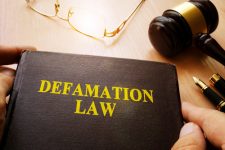What is the Law on Defamation in NSW?

Defamation is normally thought of as an act which can attract civil liability.
Indeed, a whole piece of legislation is dedicated to the rules relating to the tort of defamation in New South Wales, and there is a wealth of case law that interprets those rules.
That legislation, the Defamation Act 2005 (NSW), is substantially replicated in legislation across Australia.
However, acts of defamatory can attract both civil and criminal liability, depending on their nature and seriousness.
What is civil defamation?
The Defamation Act requires three distinct components to be proved on the balance of probabilities in order for defamation to be established:
- Publication
Material must be published (which includes orally communicated) to at least one person other than the party who was allegedly defamed.
The publication can occur orally or in writing, whether in print, by way of digital communication or otherwise, but it must be comprehensible.
- Identification
The material must identify the allegedly defamed person either directly or indirectly, or be capable of doing so.
- Defamatory meaning
The material must be ‘defamatory’ to the ‘ordinary, reasonable’ person, which means it must be likely to:
- cause the person to be shunned, shamed or avoided by others;
- adversely affect the reputation of the person in the minds of right-thinking members of society; or
- damage to the person’s professional reputation by suggesting a lack of qualifications, skills, knowledge, capacity, judgment or efficiency in his or her trade, business or profession.
Defences to civil defamation
Part 4, Division 2 of the Defamation Act lists the statutory defences, which section 24 makes clear are additional to any others available under the law.
The statutory defences are:
- Justification
Section 25 of the Act states that ‘[i]t is a defence to the publication of defamatory matter if the defendant proves that the defamatory imputations carried by the matter of which the plaintiff complains are substantially true.
- Contextual truth
Section 26 provides a defence where the defendant proves that:
- the matter carried, in addition to the defamatory imputations of which the plaintiff complains, one or more other imputations (“contextual imputations”) that are substantially true, and
- the defamatory imputations do not further harm the reputation of the plaintiff because of the substantial truth of the contextual imputations.
- Absolute privilege
Section 27 sets out the defence of absolute privilege, which relates to material published in the course of the proceedings of a parliamentary body, including (but not limited to):
- documents by order, or under the authority, of the body, and
- debates and proceedings of the body by or under the authority of the body or any law, and
- evidence before the body, and
- presentations or submissions of documents to the body.
The defence also extends material published in the course of the proceedings of an Australian court or Australian tribunal, including (but not limited to):
- documents filed or lodged with, or otherwise submitted to, the court or tribunal (including any originating process), and
- evidence before the court or tribunal, and
- any judgment, order or other determination of the court or tribunal.
The defence further extends to material which would attract absolute privilege in another Australian jurisdiction.
- Public documents
Section 28 provides a defence to publishing:
- a public document or a fair copy of a public document, or
- a fair summary of, or a fair extract from, a public document.
A public document is defined as:
- any report or paper published by a parliamentary body, or a record of votes, debates or other proceedings relating to a parliamentary body published by or under the authority of the body or any law, or
- any judgment, order or other determination of a court or arbitral tribunal of any country in civil proceedings and including:
- any record of the court or tribunal relating to the judgment, order or determination or to its enforcement or satisfaction, and
- any report of the court or tribunal about its judgment, order or determination and the reasons for its judgment, order or determination, or
- any report or other document that under the law of any country:
- is authorised to be published, or
- is required to be presented or submitted to, tabled in, or laid before, a parliamentary body, or
- any document issued by the government (including a local government) of a country, or by an officer, employee or agency of the government, for the information of the public, or
- any record or other document open to inspection by the public that is kept:
- by an Australian jurisdiction, or
- by a statutory authority of an Australian jurisdiction, or
- by an Australian court, or
- under legislation of an Australian jurisdiction, or
- any other document issued, kept or published by a person, body or organisation of another Australian jurisdiction that is treated in that jurisdiction as a public document under a provision of a law of the jurisdiction corresponding to this section.
The section states that a defence of publishing a public document can only be defeated if the plaintiff proves the defamatory material was not published honestly for the information of the public or the advancement of education.
- Fair reporting of proceedings of public concern
Section 29 makes it a defence where the defendant establishes that the defamatory material:
- was, or was contained in, an earlier published report of proceedings of public concern, and
- was, or was contained in, a fair copy of, a fair summary of, or a fair extract from, the earlier published report, and
- the defendant had no knowledge that would reasonably make the defendant aware that the earlier published report was not fair.
Proceedings of public concern is defined any proceedings:
- in public of a parliamentary body, or
- in public of an international organisation of any countries or of the governments of any countries, or
- in public of an international conference at which the governments of any countries are represented, or
- in public of:
- the International Court of Justice, or any other judicial or arbitral tribunal, for the decision of any matter in dispute between nations, or
- any other international judicial or arbitral tribunal, or
- in public of a court or arbitral tribunal of any country, or
- in public of an inquiry held under the law of any country or under the authority of the government of any country, or
- in public of a local government body of any Australian jurisdiction, or
- of a learned society, or of a committee or governing body of the society, under its relevant objects, but only to the extent that the proceedings relate to a decision or adjudication made in Australia about:
– a member or members of the society, or
– a person subject by contract or otherwise by law to control by the society, or
- of a sport or recreation association, or of a committee or governing body of the association, under its relevant objects, but only to the extent that the proceedings relate to a decision or adjudication made in Australia about:
- a member or members of the association, or
- a person subject by contract or otherwise by law to control by the association, or
- of a trade association, or of a committee or governing body of the association, under its relevant objects, but only to the extent that the proceedings relate to a decision or adjudication made in Australia about:
- a member or members of the association, or
- a person subject by contract or otherwise by law to control by the association, or
- of a public meeting (with or without restriction on the people attending) of shareholders of a public company under the Corporations Act 2001 of the Commonwealth held anywhere in Australia, or
- of a public meeting held anywhere in Australia if the proceedings relate to a matter of public interest, including the advocacy or candidature of a person for public office, or
- of an ombudsman of any country if the proceedings relate to a report of the ombudsman, or
- in public of a law reform body of any country, or
- conducted by, or proceedings of, a person, body or organisation of another Australian jurisdiction that are treated in that jurisdiction as proceedings of public concern under a provision of a law of the jurisdiction corresponding to this section.
- Qualified privilege
Section 30 makes it a defence where the defendant proves that:
- the recipient of the information has an interest or apparent interest in having information on some subject, and
- the matter is published to the recipient in the course of giving to the recipient information on that subject, and
- the conduct of the defendant in publishing that matter is reasonable in the circumstances.
In determining whether the defendant’s conduct is reasonable, the court is to consider:
- the public interest in the matter, and
- whether the material relates to the performance of public functions, and
- the seriousness of any defamatory imputation, and
- whether the material distinguishes between suspicions, allegations and proven facts, and
- whether it was in the public interest to publish the matter expeditiously, and
- the nature of the business environment in which the defendant operates, and
- the integrity of the sources of the information;
- whether the substance of the material is person’s side of the story and, if not, whether a reasonable attempt was made by the defendant to obtain and publish a response from the person, and
- any other steps taken to verify the matter published, and
- any other circumstances that the court considers relevant.
The section provides that a recipient only has an apparent interest in the information on some subject if at the time of the publication in question, the defendant believes on reasonable grounds that the recipient has that interest.
- Honest opinion
Section 31 provides a defence where the defendant, or an employee or agent of the defendant, or commentator, establishes that:
- the matter was an expression of opinion of the defendant rather than a statement of fact, and
- the opinion related to a matter of public interest, and
- the opinion is based on proper material.
Proper material is that which:
- is substantially true, or
- was published under absolute or qualified privilege, or
- was published in a context that attracted the protection of a defence under this section, or the defence of public documents or fair reporting.
The section further states that an opinion does not cease to be based on proper material only because some of the material on which it is based is such if the opinion might reasonably be based on such of the material as is proper material.
A defence of honest opinion is only defeated if the plaintiff proves that: the opinion was not honestly held by the defendant, or any employee or agent or the commentators as the case may be, at the time the defamatory matter was published,
- Innocent dissemination
Section 32 makes it a defence where it is proved the defendant:
- published the material merely in the capacity, or as an employee or agent, of a subordinate distributor, and
- neither knew, nor ought reasonably to have known, that the matter was defamatory, and
- lack of knowledge was not due to any negligence on the part of the defendant.
A subordinate distributor is someone who:
- was not the first or primary distributor of the matter, and
- was not the author or originator of the matter, and
- did not have any capacity to exercise editorial control over the content of the material or publication thereof before it was first published.
The section provides that a person is not the first or primary distributor merely because he or she was involved in the capacity of a:
- bookseller, newsagent or news-vendor, or
- librarian, or
- wholesaler or retailer of the matter, or
- provider of postal or similar services by means of which the matter is published, or
- broadcaster of a live programme,
Or the provider of services consisting of the:
- processing, copying, distributing or selling of any electronic medium, or
- operation of, or the provision of any equipment, system or service, by means of which the matter is retrieved, copied, distributed or made available in electronic form, or
Or an operator of, or a provider of access to, a communications system by means of which the matter is transmitted, over whom the operator or provider has no effective control, or
Or a person who, on the instructions or at the direction of another person, prints or produces, reprints or reproduces or distributes the matter for or on behalf of that other person.
- Triviality
Section 33 provides a defence where the defendant proves that the circumstances of publication were such that the plaintiff was unlikely to sustain any harm.
New defence
10. Responsible communication in the public interest
Introduced in 2021 after the initial publication of this article, section 29A provides a defence where the publication concerns an issue of public concern and the defendant reasonably believed it to be in the public interest.
Time limit
Section 14B of the Limitation Act 1969 (NSW) provides that ‘an action on a cause of action for defamation is not maintainable if brought after the end of a limitation period of 1 year running from the date of the publication of the matter complained of.’
However, section 56A(2) allows a court to extend that period to up to 3 years from the date of publication, ‘if satisfied that it was not reasonable in the circumstances for the plaintiff to have commenced an action in relation to the matter complained of within 1 year from the date of the publication’.
Parties that cannot be defamed
Under section 9 of the Defamation Act, companies with 10 or more employees or which are formed for something other than financial gain cannot sue for defamation.
Section 10 precludes anyone from asserting, continuing or enforcing a cause of action for defamation in respect of a deceased person, or from suing the estate of a deceased person.
Offers to make amends
Part 3, Division 1 of the Act sets out a range of rules for resolving civil defamation disputes without litigation.
The part provides mechanisms for offering to make amends without resorting to legal proceedings, and makes clear that any such offers, or admissions made therein, are not admissible in any ensuing litigation.
Criminal defamation
Section 529 of the Crimes Act 1900 (NSW) sets out the offence of ‘criminal defamation’.
Section 529(3) prescribes a maximum penalty of 3 years’ imprisonment for anyone who, without lawful excuse, publishes a matter defamatory of another living person:
(a) knowing the matter to be false, and
(b) with intent to cause serious harm to the victim or any other person or being reckless as to whether such harm is caused
Section 529(4) provides that a defendant has a lawful excuse lawful excuse if, and only if, he or she would, having regard only to the circumstances happening before or at the time of the publication, have had a defence for the publication if the victim had brought civil proceedings for defamation.
Section 529(5) makes clear that the prosecution bears the onus of negativing the existence of a lawful excuse if, and only if, evidence directed to establishing the excuse is first adduced by or on behalf of the defendant.
Section 529(7) requires the consent of the DPP before proceedings can be instituted under the section, and subsection (9) states that a prosecution under the section does not a bar civil defamation proceedings.
If you have been charged with criminal defamation and are going to court, call us anytime on (02) 9261 8881 to book a free first appointment.






